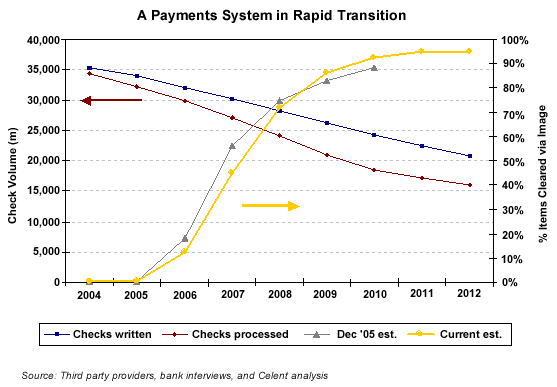Check Electronification: Roads to Rome Revisited
Abstract
After explosive growth in 2006, image exchange/share will continue to accelerate in 2007. Celent expects the percentage of checks presented electronically to grow to 45% by year end 2007. Checks converted to ACH debits will grow from 7% to 12% over the same period.
Just as Rome was not built in a day, check image exchange/share has not been either. By historical standards, however, image exchange progress has been unprecedented. Image-based clearing volume has grown nearly thirty-fold in the past year (in terms of average daily items). Now, the industry is at a cross-roads, with no agreement on which road to take. In a new report, , Celent updates a previous report on image exchange by analyzing the roadblocks to adoption and also expands the topic by covering check conversion dynamics and taking a position on the Check ACH initiative.
Although unified in its desire for electronic check processing, the industry is divided in both timing and approach to implementation. A number of large, net presenting banks, heavily invested in image exchange, wait in frustration for more image receiver banks to come online. Many smaller institutions, finding it relatively easy to adopt image exchange, wait in queue with solution providers implementing at full capacity. Meanwhile, a number of midsize banks justify inaction while waiting for the "tipping point" and its resulting, more proximate ROI. The situation is one of divided readiness and divided utilization. Driven by short-term economics, a lingering paper item processing infrastructure, and paper-centric product offerings, most large banks continue clearing original items despite having the ability to clear via image. The result is a Check 21 catch 22.
In the longer term, a concern of many banks is that of a protracted "last mile"; the fear of a sizable collection of late-adopter institutions, and a resulting spike in per-item costs for presenting paper to those institutions. Such "last mile" problems are not new. They were witnessed by the credit card industry migration from paper to electronic draft capture in the 1980s and with early ACH system deployments. In both cases, significant time elapsed between mainstream adoption and electronification of all endpoints. And in both cases, simple economic incentives were sufficient to hasten access to all endpoints. Neither scenario saw the industry seeking an alternative network infrastructure to solve the problem.
Celent, however, sees no evidence of an adoption crisis; in other words, no roadblock looms en route to Rome. The crisis, if indeed there is one, may be a crisis of unrealistic expectations.
"Image exchange volume is clearly less than it could be," says Bob Meara, author of the report and senior analyst. "Today's limiting factors do not point to an adoption crisis, however. Instead, the clear picture is one of a paradoxically difficult transition period, where existing infrastructure is being dismantled even as a new one is being built." he adds.

This report studies the current state and outlook of check image exchange and check conversion, and provides a synopsis and position on the Check ACH Coalition initiative.

